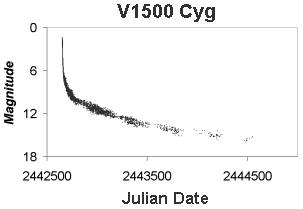The spectacular nova V1500 Cygni burst into the evening sky on August 29, 1975, disrupting the familiar outline of the Northern Cross. Many independent visual discoveries of this magnificent nova were made, particularly Minoru Honda from Kurashiki, Japan, who first discovered the nova at a visual magnitude of 3.0 on August 29th. The nova soared to a peak magnitude of 2.0 the next day, then rapidly faded down 3 mags. in three days, descending a total of 7 mags. in 45 days! V1500 Cyg was the fastest, largest amplitude (~ 19 mag.), and second most intrinsically bright nova of the last century (only Nova Puppis 1942 was brighter).
 |
| Visual light curve of V1500 Cygni from the AAVSO International Database; March 28, 1975, to September 17, 1980 |
Since the 1975 outburst, observational data of V1500 Cyg indicates that this nova is a magnetic cataclysmic binary of the AM Her class, that is that the white dwarf component has a strong magnetic field that inhibits the formation of an accretion disk and almost synchronizes the rotational period with the orbital period. V1500 Cyg is the 13th confirmed AM Her-type system, with the second longest orbital period ( ~3.3 hours) (Chlebowski and Kaluzny, 1988).

